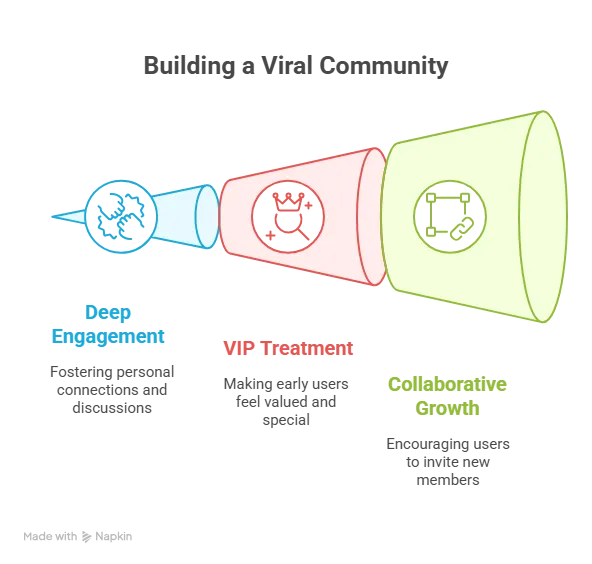You’ve just launched your social networking app. It’s sleek, it’s functional, and it’s packed with features you know people will love—feeds, groups, stories, maybe even audio rooms. But the download numbers are crawling, your DAUs aren’t where you hoped, and your early users are eerily silent. Sound familiar?
This isn’t failure. This is the reality of launching a community product. Building the network is one thing; getting people to actually use it, engage, and bring their friends—that’s the uphill climb. And unfortunately, that hill is steep. But not impossible.
Whether you’ve built a Facebook Clone, a hyperlocal interest-based network, or a niche platform for hobbyists, your marketing playbook needs to be tailored, persistent, and emotionally resonant. Because a social app is only as strong as the relationships it enables—and relationships need nurturing, not just code.
At Miracuves, we help founders and creators not just launch feature-rich social network clones, but also scale them into sticky, thriving communities through smart post-launch strategies.
Start With a Core Tribe

Every viral social app started with a small, passionate group. Facebook began in a dorm. Reddit grew out of niche forums. Your job post-launch is to find and empower your tribe.
That might be sneakerheads, indie musicians, gamers, spiritual seekers, or language learners. Don’t cast the net too wide early on. Focus on building deep engagement with a tight circle—where people know each other, conversations feel organic, and the value is personal.
Host virtual meetups, seed discussions, spotlight members. Your first 100 users should feel like VIPs. Treat them as collaborators, not just consumers. They’ll be the ones who invite the next 1,000.
Engineer a Strong Onboarding Experience
Onboarding isn’t just about showing users where the buttons are—it’s about showing them why they should stay.
Walk them through setting up a profile, joining a group, posting their first comment. Use interactive tutorials, progressive tooltips, or even gamified welcome quests. Let users find people they already know—import contacts, connect with Facebook friends, follow suggested profiles.
The goal? Get them to their first “aha!” moment in under 2 minutes. That might be a reply to a post, a like on their profile, or a comment on their photo. Social feedback is addictive—trigger it early.
Create Conversations, Not Just Content
Too many social platforms die a slow death because users sign up… and then find silence.
Seed conversations. If you’re launching a community app around art, have a few creators post behind-the-scenes of their work. If your app is for fitness, start a 30-day challenge and let users share progress. Add conversation starters, trending hashtags, daily polls—anything that nudges people to interact.
Also, don’t be afraid to participate as the brand. Comment, engage, tag people. The early stage of a community app is like hosting a party—you’ve got to get the small talk going until it takes on a life of its own.
Read More : How to Start a Social Media App Development Business from Scratch
Leverage Micro-Influencers and Niche Celebs

Celebrity endorsements are expensive. Micro-influencers, on the other hand, are not just affordable—they’re often more trusted.
Find thought leaders or creators in your app’s niche. Reach out with early access, perks, or features. Let them shape parts of the platform—like group topics or new features. You don’t need 1M followers to move the needle. Sometimes, a YouTuber with 10K engaged subscribers in a niche is worth more than a generic mega-influencer.
Make them part of the narrative. People love joining platforms where their favorite voices are already active.
Master the Art of Referral Hooks
Social apps are perfectly positioned to go viral—if you give users a reason to invite others.
Add built-in referral links. Offer benefits not just for inviting, but for interacting with new users. For instance: “Start a group with 3 friends and get exclusive badges.” Or “Get 50 followers and unlock creator analytics.”
Also, integrate shareable content into the app itself. Let users post their activity to Instagram, tweet their new group creation, or share a viral thread externally with “Join the conversation” CTAs.
Retention Over Reach: Focus on Active Users
Yes, you want downloads. But 1,000 engaged users are more valuable than 10,000 ghost profiles.
Use behavior-triggered push notifications: “Your post is trending,” “5 new members joined your group,” or “@Priya replied to your comment.” Avoid spammy reminders. Make each ping feel like a signal, not noise.
Weekly digests, creator spotlights, or top community discussions via email can also keep your users looped in—even if they’re not checking the app daily.
Run Experiments—Then Double Down on What Works
Don’t market on autopilot. Try multiple approaches—Instagram reels, Reddit AMA, Discord events, YouTube podcasts, or even quirky in-app badges.
Track what drives engagement. Maybe your audience loves community challenges more than video content. Maybe they respond better to email than push notifications. A/B test, gather feedback, iterate. Your audience will show you the way—if you listen.
Tools like Mixpanel, Amplitude, or Firebase can help track key metrics: retention curves, bounce rates, interaction depth, and feature usage.
Read More : How to Develop a Social Networking and Community Platform
Build a Brand People Want to Belong To
People don’t join platforms. They join movements.
So what’s your movement? Are you giving Gen Z a platform free from filters? Are you empowering professionals to speak freely? Are you helping LGBTQIA+ creatives find each other?
Infuse your mission into your messaging. Make your values clear in the copy, the visuals, the features. When people resonate with your “why,” they’ll stick around longer—even when your tech isn’t perfect.
Don’t Ignore Press and Thought Leadership
Pitch your story to startup publications, tech newsletters, niche podcasts, or even student communities. You don’t need to be big to be interesting. Share your journey, your team’s background, or the problem your app is solving.
Stories like “Built by musicians, for musicians” or “Helping remote workers connect through hyperlocal chat” can earn you PR—and PR builds credibility, especially when you’re small.
Read More : Revenue Model for Social Networking and Community Platform
Final Thoughts
Social networking apps are like bonfires. You spark the flame, but it’s the people who keep it burning.
Marketing one post-launch isn’t just about virality—it’s about cultivating depth, community, and momentum. With the right people, product, and persistence, your platform can find its tribe—and scale far beyond it.
At Miracuves, we help innovators launch high-performance app clones that are fast, scalable, and monetization-ready. Ready to turn your idea into reality? Let’s build together.
FAQ
Still have questions about marketing a social networking app? Let’s clear them up.
How do I get my first users without a big budget?
Focus on niche communities and micro-influencers. Reach out directly, offer value, and engage deeply.
What’s more important—features or users?
In the early stage, users matter more. Even basic features can work if there’s an active, passionate user base.
How do I reduce churn?
Improve onboaring, send relevant push notifications, and make users feel seen and celebrated within the app.
Should I build a mobile app or start with a web platform?
Mobile is essential for social apps—but web can be a powerful onboarding tool, especially for desktop-first audiences.
Can I monetize a social app early?
Yes, but carefully. Test things like premium groups, creator tips, or ad placements after you hit strong retention numbers.
Can Miracuves help with growth, not just development?
Definitely. We work closely with our clients on post-launch strategies, product improvements, and growth loops.








